FMA Congratulates Student Artists
- Details
- Written by: Joanne Wallenstein
- Hits: 2063
 Work by October SHS Artist of the Month and Katonah Museum of Art exhibitor Amy SaxonScarsdale’s got talent, as evidenced in the awarding winning artwork by Scarsdale High School students.
Work by October SHS Artist of the Month and Katonah Museum of Art exhibitor Amy SaxonScarsdale’s got talent, as evidenced in the awarding winning artwork by Scarsdale High School students.
Friends of Music and the Arts congratulates the following SHS student artists whose work was recognized in the 2022 Scholastic Art and Writing Awards Competition: See some of their work below.
2022 Scholastic Art and Writing Award Winners Work by February SHS Artist of the Month and Katonah Museum of Art exhibitor Eve Rich
Work by February SHS Artist of the Month and Katonah Museum of Art exhibitor Eve Rich
Joe Dimartino - Multiple Gold and Silver Key Awards
Angela Chiang - Honorable Mention in Painting
Carson Cohen - Honorable Mention in Photography
Jonathan Conway - Honorable Mention in Photography
Catheryn Dundon - Honorable Mention in Fashion Design
Olivia Gao - Honorable Mention in Painting
 Work by November SHS Artist of the Month and Katonah Museum of Art exhibitor Livvie Halligan
Work by November SHS Artist of the Month and Katonah Museum of Art exhibitor Livvie Halligan
FMA offers congratulations to the following SHS students whose work has been selected for exhibition.
2022 Katonah Museum of Art Young Artists Show Exhibitors | Feb 6-27, 2022
Eve Rich
Amy Saxon Work by March SHS Artist of the Month and Katonah Museum of Art exhibitor Wubet Jean-Baptiste
Work by March SHS Artist of the Month and Katonah Museum of Art exhibitor Wubet Jean-Baptiste
Kivrin Wachtel
Raffaella Vogt
Olivia Halligan
Anja Li
Jonathan Wallach
Wubet Jean-Baptiste
Jack Lattman
For show details and exhibit images, click here.
SHS Artists of the Month
September: Rafaella Vogt
October: Amy Saxon
November: Livvie Halligan
December: Olivia Liu
January: Aitana Ibanez Mendoza
February: Eve Rich
March: Wubet Jean-Baptiste
April: Julia Hoffman (2D art) & Ethan Lowey (3D art)
Work from each artist is on display in the high school auditorium lobby for the featured month, and can also be seen here. https://sites.google.com/scarsdaleschools.org/scarsdale-hs-art-department/home?authuser=0
For more info about FMA, to volunteer with the newly formed FMA Art Committee, and to support our work, visit www.scarsdalearts.org or contact fmascarsdale@gmail.com.
 Work by April SHS Artist of the Month Julia Hoffman (2D art)
Work by April SHS Artist of the Month Julia Hoffman (2D art)
 Work by December SHS Artist of the Month Olivia Liu
Work by December SHS Artist of the Month Olivia Liu
 “Anxiety” by SHS sophomore Olivia Gao. Scholastic Honorable Mention in Painting
“Anxiety” by SHS sophomore Olivia Gao. Scholastic Honorable Mention in Painting
 Work by September SHS Artist of the Month and Katonah Museum of Art exhibitor Raffaella Vogt
Work by September SHS Artist of the Month and Katonah Museum of Art exhibitor Raffaella Vogt
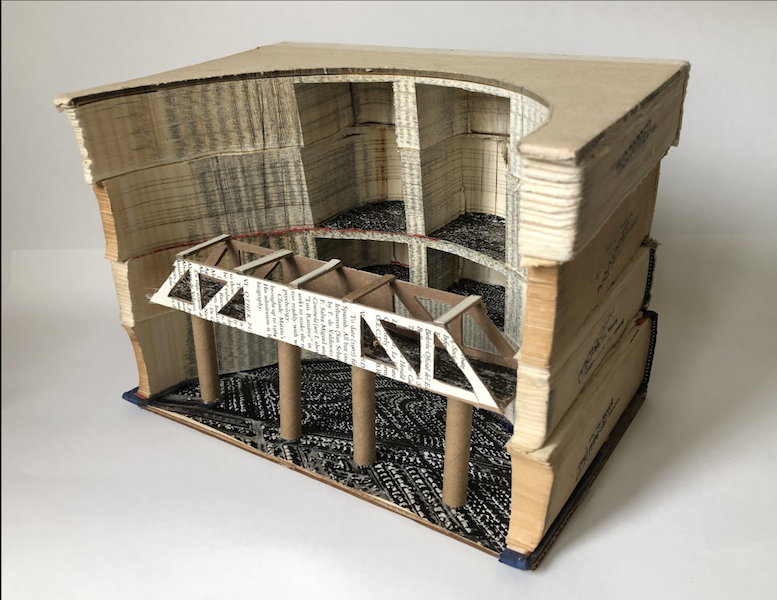 Work by April SHS Artist of the Month Ethan Lowey (3D art)
Work by April SHS Artist of the Month Ethan Lowey (3D art) Work by January SHS Artist of the Month Aitana Ibanez Mendoza
Work by January SHS Artist of the Month Aitana Ibanez Mendoza
Children's Author Dan Gutman Explains How to Write Your Story in Nine Simple Steps at the Young Writers' Workshop
- Details
- Written by: Joanne Wallenstein
- Hits: 1828
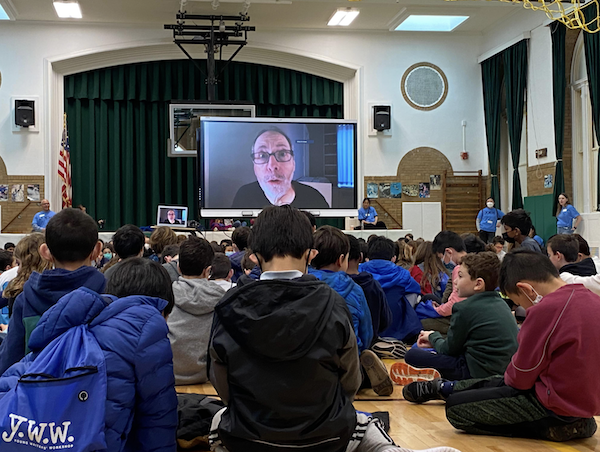 Author Dan Gutman addressed the group in the Greenacres gym.On Saturday, March 26, 2022, Scarsdale held its 27th Annual Young Writers workshop from 9 am to 12 pm at Greenacres Elementary School for 3rd through 5th graders. Second graders also had the option to virtually connect with keynote speaker Dan Gutman for an introduction to the Young Writers’ Workshop.
Author Dan Gutman addressed the group in the Greenacres gym.On Saturday, March 26, 2022, Scarsdale held its 27th Annual Young Writers workshop from 9 am to 12 pm at Greenacres Elementary School for 3rd through 5th graders. Second graders also had the option to virtually connect with keynote speaker Dan Gutman for an introduction to the Young Writers’ Workshop.
Dan Gutman, an American author of primarily children’s fiction, began the day’s event by delivering a presentation to the young students over Zoom. Gutman first talked about how he never loved to read as a young child, but soon discovered how fun it could be. He showed the students the variety of books he has published and taught them how to write their own stories in nine simple steps. Gutman read the first chapter of his newest book My Weirder-est School #11: Mrs. Stoker Is a Joker as well, which will be released in June. He concluded his presentation by showing the students a series of his rejection letters to deliver messages of perseverance.
The students then had the option to spend the morning at two workshops, which they selected from a list of seventeen offerings.
From residents like designer Chip Rich and journalist Ines Rodrigues to award-winning authors including Jacqueline Friedland as well as Laura Schaefer, the students had the opportunity to learn about all forms of writing, art, and multimedia. The sessions were scattered around the newly renovated Greenacres—the four-classroom addition, rearrangement of interior spaces, and the renovation of eleven classrooms contributed to the school acting as the perfect space for the event.
In the “Diary of a Bunny: Storytelling Furry Perspective!” Laura Schaefer, the author of The Crumbles Chronicles: Tails of a Nervous Dog and owner of Scattered Books Bookstore, led the students in a postcard story-telling activity. As the students developed their own stories with creative titles and interesting drawings, Schaefer brought around her bunny Pumpkin, who serves as her bookstore's mascot, for the children to pet.
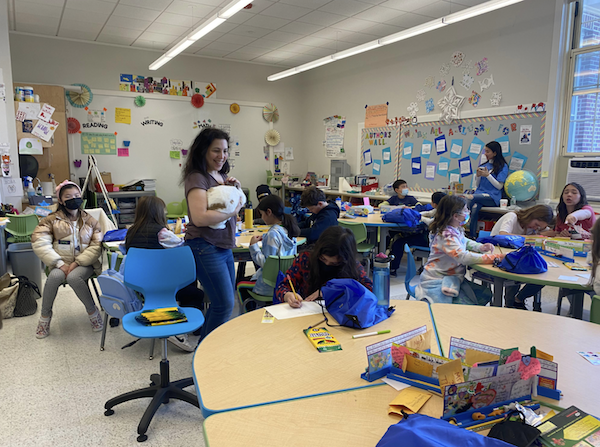 Schaefer brought around her pet bunny Pumpkin to the workshop.
Schaefer brought around her pet bunny Pumpkin to the workshop.
Dan Gutman’s “My Weird Writing Workshop!” allowed the children to collectively craft a story about a mermaid named Kevin who wants to make a robot friend in a robot factory—the students alternated giving suggestions for a character, setting, and a goal and many laughs were had along the way.
Local pop artist Michael Albert allowed the students to dive into the world of art as they crafted collages made from recycled cardboard food boxes while listening to the Beatles. One student even took the opportunity to create a flag of Ukraine with the words “Stop the War” for her project. The students left the “Famous Pop Artist Lead Collage Workshop” with a new art project as well as postcards and bookmarks of Albert’s most famous prints. The elementary school students even learned the craft of commercials with local Creative Director Chip Rich.
The Young Writers’ Workshop proved to be an enjoyable and exciting event yet again for the students, guest participants, and volunteers alike.
Commenting on the event, organizers Jill Casal and Georgina Sforza said, "
Commenting on the event Casal said, “We had 350 students participate this year, in grades 2-5 (grades 3-5 in person, and grade 2, we piloted an "Intro to YWW" session virtually, where the children could watch the keynote with Dan Gutman livestreamed at home, to get a taste of the event before attending next year as third graders!).
It was truly wonderful to see all of the children back together. They reveled in the keynote with Dan Gutman, then moved from classroom to classroom for the various workshops. We thank Sharon Hill and Sharon DeLorenzo for allowing us to use the beautiful new Greenacres space for the event (it was the perfect spot for this event). And we also thank our wonderful community of volunteers -- over 50 parents from all five elementary schools helped the day of the event to make sure the event ran smoothly for the kids. It takes a village, and the village, as always, was present!
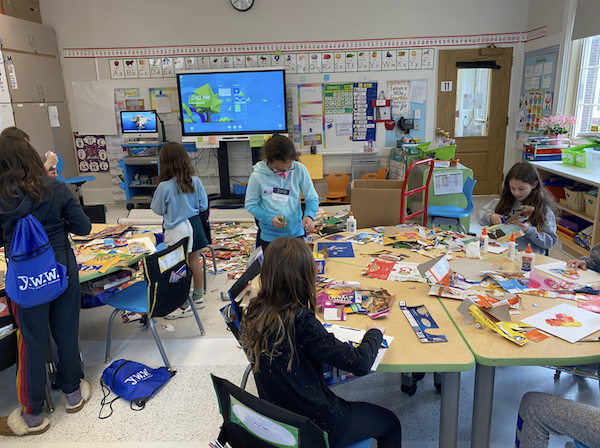 Student's in Michael Albert's workshop crafted collages from recycled carboard food boxes.
Student's in Michael Albert's workshop crafted collages from recycled carboard food boxes.
Heathcote Elementary Celebrates Blue Ribbon Award
- Details
- Written by: Joanne Wallenstein
- Hits: 3446
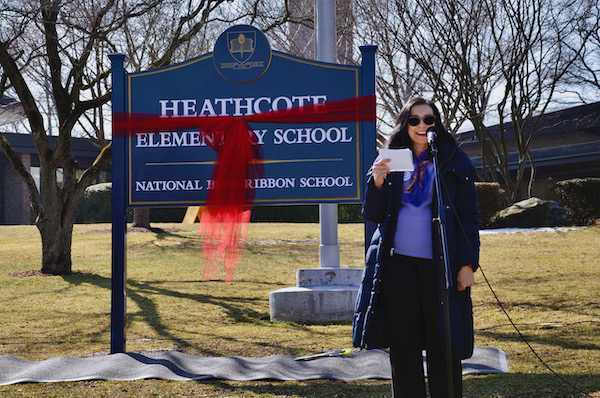 Heathcote Elementary School was recognized as a National Blue Ribbon School in 2020 by the U.S. Depatment of Education, a designation that lasts for 5 years.
Heathcote Elementary School was recognized as a National Blue Ribbon School in 2020 by the U.S. Depatment of Education, a designation that lasts for 5 years.
The program recognizes schools based on their overall academic excellence or their progress in closing achievement gaps among student subgroups. Now in its 39th year, the National Blue Ribbon Schools Program has bestowed more than 10,000 awards to over 9,000 schools. The award affirms the hard work of students, educators, families and communities in creating safe and welcoming schools where students master challenging and engaging conent.
Due to COVID, the ribbon cutting ceremony was postponed until March 11, 2022, when a new sign proclaiming the award was unveiled. PTA board members, the Principal and Vice Principal led the ceremony and cut the ribbon. There was also a guest appearance of the school mascot, the Heathcote Husky, which thrilled the kids.

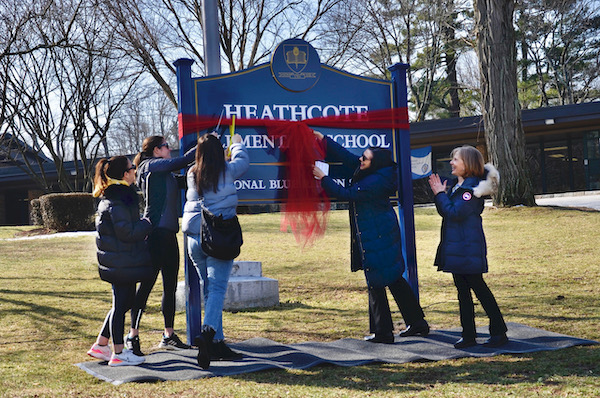
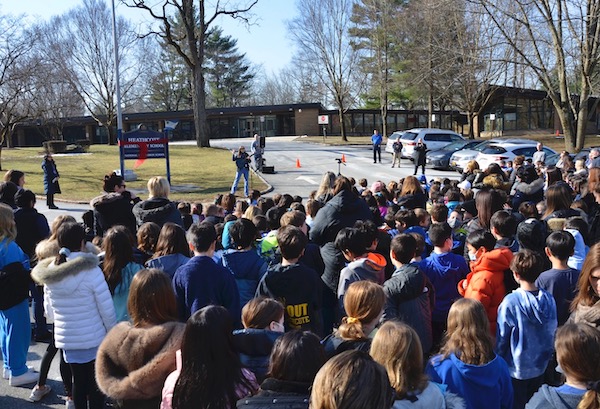
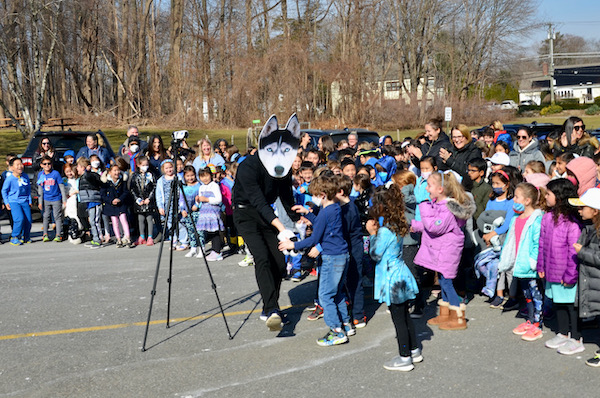
Judges Needed for SMS Speech Contest
- Details
- Written by: Joanne Wallenstein
- Hits: 1906
 The Scarsdale Middle School Speech Contest will be held on Thursday March 24, 2022 and judges are needed. Will Maldarelli, a teacher and coordinator of the event is inviting interested adults in the community and high school students who are members of the Speech and Debate Club to serve as judges.
The Scarsdale Middle School Speech Contest will be held on Thursday March 24, 2022 and judges are needed. Will Maldarelli, a teacher and coordinator of the event is inviting interested adults in the community and high school students who are members of the Speech and Debate Club to serve as judges.
Here is the schedule
4:00-4:30 judges sign in and rounds begin with the preliminary rounds ending at approximately 7:00 pm.
A light buffet dinner, courtesy of the PTA, will be served after these preliminary rounds
Finals to end by 9:00 pm.
To register, please use the Google form:
If you have any questions about the registration process, please contact Steven Scharf at sscharf@scarsdaleschools.org.
Scholarships Available for Scarsdale Students
- Details
- Written by: Joanne Wallenstein
- Hits: 1734
 College scholarship funds are available for graduating high school senior and for Scarsdale students currently attending college. See below for details on how to apply.
College scholarship funds are available for graduating high school senior and for Scarsdale students currently attending college. See below for details on how to apply.
Scarsdale High School PTA Scholarship Fund for College
Scarsdale seniors may apply for a one-year grant from the Scarsdale High School PTA Scholarship Fund. To learn more about the Scholarship Fund, who is eligible and how to apply, please refer to Fund Facts linked here.
Applications can be accessed through the link to a google form from the Scholarship Fund Webpage.
Completed applications must be submitted by Monday, May 2nd.
For additional information regarding the Scholarship Fund, please contact Laurie Medvinsky at lauriemedvinsky@gmail.com.
Scarsdale Foundation Offers Scholarship Aid
Students who graduated from Scarsdale High School or lived in Scarsdale during their high school years and who have completed their first, second, or third years of college are invited to apply to the Scarsdale Foundation for tuition assistance. For the 2021-2022 academic year, the Foundation awarded need-based grants totaling $139,000 to 31 students attending private and state-supported colleges and universities.
Applications for the 2022-2023 academic year should be submitted online from the Scarsdale Foundation’s website: www.scarsdalefoundation.org (click on the College Scholarships link). Completed applications must be submitted by Wednesday, June 1, 2022. Questions should be directed to Scholarship Committee Co-Chairs Anne Lyons or B. Kathleen Munguia at: scarsdalefoundationscholarship@gmail.com.
The Foundation welcomes contributions from the community to augment the funds available for distribution each year. Contributions may be donated to a specially earmarked Scholarship Fund of the Scarsdale Foundation, enabling the Foundation to carry on the tradition of helping students in need pursue a college education. Donations may be made online by visiting the Foundation’s website or mailed to the Scarsdale Foundation at P.O. Box 542, Scarsdale, NY 10583.
The Foundation also hosts the Scarsdale Bowl Dinner where Scarsdale individuals are recognized for their volunteer service to the community. The Scarsdale Bowl will be presented to the 2022 recipient on Thursday, April 28 at the Brae Burn Country Club. The 2020 and 2021 Bowl recipients will be honored at the April dinner as well.
- Administration Proposes 4% Increase for 2022-23 Scarsdale School Budget
- BOE Asks for Your Feedback On Search for an Interim Superintendent
- Special Education Program Offers a Wide Variety of Programming to Scarsdale Students
- School Administration Proposes Significant Increase in Mental Health Staffing










